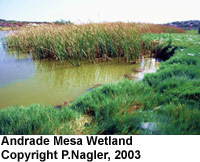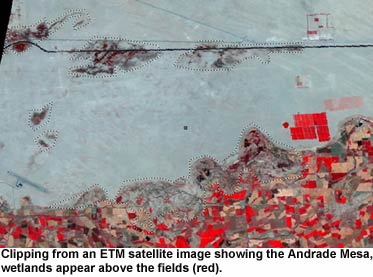|
Newly discovered wetlands of the Andrade Mesa
The authors of the study are Osvel Hinojosa-Huerta, Pamela Nagler, Yamilett Carrillo-Guerrero, Enrique Zamora-Hernandez, Jaqueline Garcia-Hernandez, Francisco Zamora-Arroyo, Kara Gillon and Edward Glenn.
 The
wetlands are in the northern Colorado River delta near the Andrade
Mesa, east of Drop 3 where the proposed lining will end. Although
the wetlands may have been present as early as 1901, since the first
gravity canals were placed across the Andrade Mesa, these wetlands
had not been deemed important until their recent discovery from
an aerial survey of the delta on June 3, 2002. The survey was followed
by a second aerial survey on June 18, 2002, and by several ground-truthing
expeditions to determine vegetation types and bird species. They
support high-quality bird habitat including sensitive, endangered
and locally rare species.
The
wetlands are in the northern Colorado River delta near the Andrade
Mesa, east of Drop 3 where the proposed lining will end. Although
the wetlands may have been present as early as 1901, since the first
gravity canals were placed across the Andrade Mesa, these wetlands
had not been deemed important until their recent discovery from
an aerial survey of the delta on June 3, 2002. The survey was followed
by a second aerial survey on June 18, 2002, and by several ground-truthing
expeditions to determine vegetation types and bird species. They
support high-quality bird habitat including sensitive, endangered
and locally rare species.
Currently, the All American Canal is not lined,
which means that a portion (2%) of the 300 m3/sec of water flowing
through the Canal is currently lost to seepage. Most of this is
pumped up for agriculture
in Mexico, but a small amount, west of the pumped area, supports
this group of wetlands known as Las Pangas in Mexico. There are
nearly 20 separate wetland areas, totaling an area of nearly 6,200
ha, with the smallest wetland at ~111 ha and the largest at ~3,025
ha. Approximately 3,500 ha of the total wetland area is east of
the proposed lining of the Canal, and would therefore be adversely
impacted by this project. There are three main types of habitat:
marshes (18%), consisting of open water surface and emergent vegetation;
playas (31%), consisting of dry, alkaline lakebeds that are mixtures
of bare and vegetative cover; and dunes (51%), consisting of vegetation
cover at approximately 58% inside the wetlands compared to only
6% outside the wetlands. agriculture
in Mexico, but a small amount, west of the pumped area, supports
this group of wetlands known as Las Pangas in Mexico. There are
nearly 20 separate wetland areas, totaling an area of nearly 6,200
ha, with the smallest wetland at ~111 ha and the largest at ~3,025
ha. Approximately 3,500 ha of the total wetland area is east of
the proposed lining of the Canal, and would therefore be adversely
impacted by this project. There are three main types of habitat:
marshes (18%), consisting of open water surface and emergent vegetation;
playas (31%), consisting of dry, alkaline lakebeds that are mixtures
of bare and vegetative cover; and dunes (51%), consisting of vegetation
cover at approximately 58% inside the wetlands compared to only
6% outside the wetlands.
These wetlands were not mentioned in the 1994 ESA although they are only a few miles from the canal in Mexico. Feel free to contact Osvel, osvel@email.arizona.edu, if you want more information about the birds and ecological value of this habitat. For maps and photographs of the region, please contact Pamela Nagler, pnagler@ag.arizona.edu. |

 The
wetlands are in the northern Colorado River delta near the Andrade
Mesa, east of Drop 3 where the proposed lining will end. Although
the wetlands may have been present as early as 1901, since the first
gravity canals were placed across the Andrade Mesa, these wetlands
had not been deemed important until their recent discovery from
an aerial survey of the delta on June 3, 2002. The survey was followed
by a second aerial survey on June 18, 2002, and by several ground-truthing
expeditions to determine vegetation types and bird species. They
support high-quality bird habitat including sensitive, endangered
and locally rare species.
The
wetlands are in the northern Colorado River delta near the Andrade
Mesa, east of Drop 3 where the proposed lining will end. Although
the wetlands may have been present as early as 1901, since the first
gravity canals were placed across the Andrade Mesa, these wetlands
had not been deemed important until their recent discovery from
an aerial survey of the delta on June 3, 2002. The survey was followed
by a second aerial survey on June 18, 2002, and by several ground-truthing
expeditions to determine vegetation types and bird species. They
support high-quality bird habitat including sensitive, endangered
and locally rare species. agriculture
in Mexico, but a small amount, west of the pumped area, supports
this group of wetlands known as Las Pangas in Mexico. There are
nearly 20 separate wetland areas, totaling an area of nearly 6,200
ha, with the smallest wetland at ~111 ha and the largest at ~3,025
ha. Approximately 3,500 ha of the total wetland area is east of
the proposed lining of the Canal, and would therefore be adversely
impacted by this project. There are three main types of habitat:
marshes (18%), consisting of open water surface and emergent vegetation;
playas (31%), consisting of dry, alkaline lakebeds that are mixtures
of bare and vegetative cover; and dunes (51%), consisting of vegetation
cover at approximately 58% inside the wetlands compared to only
6% outside the wetlands.
agriculture
in Mexico, but a small amount, west of the pumped area, supports
this group of wetlands known as Las Pangas in Mexico. There are
nearly 20 separate wetland areas, totaling an area of nearly 6,200
ha, with the smallest wetland at ~111 ha and the largest at ~3,025
ha. Approximately 3,500 ha of the total wetland area is east of
the proposed lining of the Canal, and would therefore be adversely
impacted by this project. There are three main types of habitat:
marshes (18%), consisting of open water surface and emergent vegetation;
playas (31%), consisting of dry, alkaline lakebeds that are mixtures
of bare and vegetative cover; and dunes (51%), consisting of vegetation
cover at approximately 58% inside the wetlands compared to only
6% outside the wetlands.